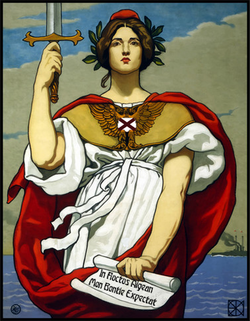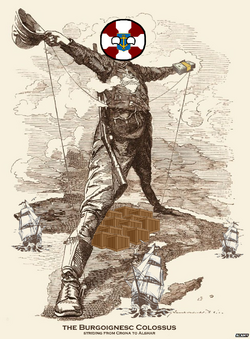Caffeine Consumption in Burgundie
| This article is part of a series on the |
| Culture in Burgundie |
|---|
 |
| Society |
| Arts and literature |
| Other |
|
Burgundie portal |
| This article is part of a series on the |
| Economy of Burgundie |
|---|
 |
| Economy |
| Policies |
| Alliances and Trade Agreements |
| History and culture |
| Key components |
|
Burgundie portal |
Tea
In 2028 on a per capita basis Burgundians consumed 1.4 kgs of tea, totalling 2,800,000 kgs or 6,172,943 lbs of tea leaves. Some scholars and tea lovers find this statistic misleading because according to the Department of Food and Nutrition, from whom this statistic originated, there is no distinction between tea, chai, and tisane. In many circles, tea and tisane are considered on par with one another, with only extreme purists rejecting tisane, but most tea lovers in Burgundie agree that chai is a unique drink from tea itself. While chai and tea are the same word, the latter being a foreign bastardization of the Daxian chá (茶) (Eng. chai), they have come to refer to two separate beverage experiences in Burgundie. Tea is the traditional boiled water with various leaves of the Camellia sinensis and served directly into a cup, normally with a small wide bowl and a handle. Meanwhile, chai is boiled water with various leaves of the Camellia sinensis, steeped for 5-15 minutes to let it cool and then poured from a height of at least 20 cm, various traditions and shops in The Burgundies pour from differing heights, normally over condensed milk to give it a creamy, frothy texture. Chai is served in a tall slender glass with a brass, or other ornamental metal, zarf. Tisane is boiled water with various leaves not of the Camellia sinensis and served directly into a cup, normally with a small wide bowl and a handle.
Monteangeline Tea
Starting in 1578 the Burgundians have been importing tea from Monteangelo, with the exception of between 1820-1897. In 1578 the Burgundian South Levantine Trading Company established an emporium which later became Vitale in southeastern Monteangelo. They worked with the inhabitants of the island, some remnants of the native Phaxsos population, Bergendii peasants, and various seafarers who had made the islands their home, to trade for tea leaves and other resources. In the early 1600s, the company started creating a series of organized tea leaf plantations across the highlands. The first plantations encircled the middle range of Mt. Anghel where the most desirable tea leaves had been cultivated by the natives. The company created a highway from Vitale to the foothills of Mt. Anghel with a series of forts along the route to protect the tea in transit. As the plantations grew, the company established a small army to protect its investment, following the successful model being utilized by the Burgundian West Punth Trading Company at that time. As the eastern colonies of the Burgundian West Punth Trading Empire started to produce high-quality teas of their own the need for an expanded operation in Monteangelo became apparent to the Burgundian South Levantine Trading Company. Productivity skyrocketed in the 1700s as new plantations were opened across Hautterre and the port of Vital was expanded. Drawing workers from across Fiannria, especially the Duchy of Burgundie, and Ixnay, the population of Monteangelo boomed from approximately 50,000 to 150,000 between 1578 and 1804. Vast infrastructure projects crisscrossed the island and the growth of the Burgundian South Levantine Trading Empire seemed inevitable.
In 1804 a hurricane ravaged the southeastern coast of the island and destroyed Vitale. The rains drowned much of that year's tea crop as well. Just as the plantations were starting to recover in 1805 a cholera outbreak struck the population, which because of the road network, spread rapidly across the island. New workers were brought in from Ixnay but they brought a second bought of cholera in 1807. The productivity, greatly hampered was unable to recover. The vacuum left by the lack of tea coming out of Monteangelo and southern Punth was soon filled by the Burgundian Grand Crona Trading Empire's imports of Cartadaniaan coffee. By the time that the operations on Monteangelo were restored to merely half of their previous capacity the Burgundian South Levantine Trading Empire had moved its focus elsewhere and the Monteangeline adventure was abandoned. The last Burgundian South Levantine Trading Company ship with tea left on August 9, 1820.
In 1897 with the formation of the Esprit de Corps, the Burgundian markets were once again introduced to Monteangeline tea. There was a buying frenzy between 1897 and 1901 that led to inflationary prices on some tea leaves of up to ₮20/kilogram (approx. $520.66 in 2021). The market corrected as Punthite teas were also reintroduced to the market in the 1910s. Throughout most of the 20th century tea leaves from Monteangelo have provided a staple breakfast tea to the Burgundian market. In the 21st century, the prominence of third wave teas exploded and Monteangelo's developed infrastructure and strong central government were able to more quickly adapt then the plantations in Punth. In the Burgundian market over the last 15 years the market share of Monteangeline tea versus Punthite tea as reversed with Monteangelo representing 67% of the market.
Punthite Chais and Tisanes
With the colonization by the Burgundian West Punth Trading Company of the territories known to them as Dwemers Colony and Pukhgundi Colony in the mid 17th century, Punthite teas have been brought into the Burgundian market. Due to the long journey, they were considerably more expensive than the tea from Monteangelo and were consumed only by the countries elites. The Burgundian West Punth Trading Company, now styled the Burgundian West Punth Trade Empire established a strong plantation system to compete with their Burgundian South Levantine Trading Company rivals in Monteangelo. The operation brought thousands of Bergendii and other occidental workers and prospectors to the north-west coast of southern Punth in the mid 18th century, and is sighted as one of the main reasons for the Dwemers and Pukhgundi colonies joining in the revolts of the late 18th and early 19th centuries. The massive influx of foreign workers and the systemic improvement of the land forced the natives to completely change their culture. The tea production spiked in north-western south Punth in 1785. Subsequent years were plagued by insurrectionist activity that hampered the ability to harvest and transport the leaves with impacted the exports dramatically.
Dwemer
Chai and tisane
Shanjin
Chai, origin of the word chai, tea ceremony, origin of Burgundian high-tea
Coffee
Cartadaniaan Coffee
Main article: Coffee production in Cartadania
Pelaxian Coffee
Soda
Imperial Cola
Cocktails
Impact on society
Coffee and tea started Burg (Kilikas?) enlightenment because people were pepped up instead of drunk, but only rich people could afford it. In the 1960s with the introduction of Imp Cola to the masses there was a cultural revolution as even the poors were pepped up and lead to The Great Tumult.